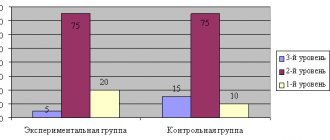An important indicator of the intelligence of a preschooler is the development of speech at the age of 5-6 years. At this age, the child knows 3000-4000 words and pronounces most of the sounds correctly. Children are able to construct detailed phrases and give detailed descriptions. To improve pronunciation and develop vocabulary, didactic games, finger and articulation gymnastics are used.
The speech development of a 4-5 year old child is very important.
Speech development in preschoolers
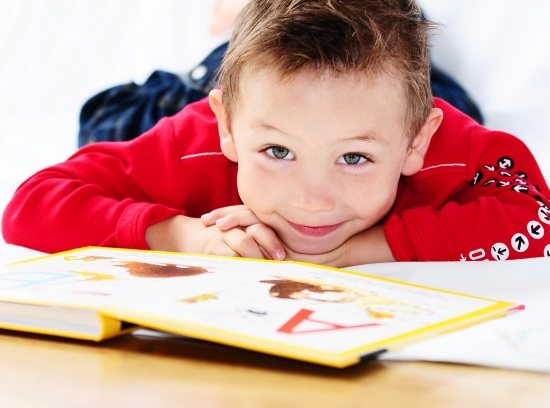
Normally, by the age of 5-6 years of life, a child’s speech is similar to an adult’s. The main task of developing the ability to correctly express one’s thoughts in a conversation is to prepare a preschooler for learning to read and write. If your baby has difficulty differentiating sounds, he will inevitably have problems writing letters.
A limited vocabulary and inability to consistently express thoughts will not allow the student to retell what he has read or explain the solution to an example.
And you should start preparing for school early and gradually. The tutor will be able to quickly prepare the child. However, the effectiveness of such intensive classes will lose its relevance after 1-2 quarters if the preschooler has speech disorders. Therefore, it is worth starting to prepare for admission to 1st grade 1.5-2 years in advance.
Vocabulary
At 5 years old, a child should actively use about 3-3.5 thousand words. He knows how to generalize concepts (plants, animals, dishes, clothes). In the speech of a preschooler, there are not only the names of everyday objects, but also abstract concepts - love, resentment, planet, universe, etc.
Children 5-6 years old love vocabulary games with rearranging words or making mistakes in the text. Eg:
- The bathhouse ran past the man, and the gate growled at our cat.
- I chopped the ax with my notebook, and the fence jumped over the cat Egorka.
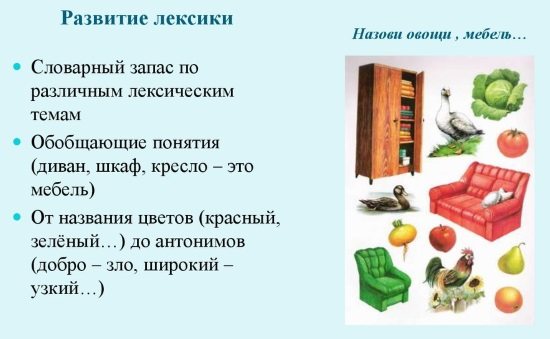
Grammar
Short answers become longer and more detailed. Children already know how to correctly decline complex forms of nouns. However, they may make mistakes by saying kittens instead of kittens or calves instead of calves. The following speech games help develop grammar:
- “Say it the other way around” is a game to find antonyms.
- "Broken phone."
- "Guess what I'm talking about."
- “Finish the sentence.”
The model of literacy is the adults who surround the baby. If family members have problems with the correct placement of stress, speech disorders, or abuse of slang and obscene words, the child will copy them.
Articulation
The vocal apparatus of a preschooler corresponds to that of an adult. If there are no anatomical disorders - a shortened frenulum, malocclusion - children pronounce most phonemes correctly. Most often, children 5-6 years old have difficulty pronouncing the sound “r”. They either replace it with a simpler “l” or “y” - balsuk, not badger, yak, - not cancer, or skip it altogether - baaban instead of drum, vaenik instead of dumpling.
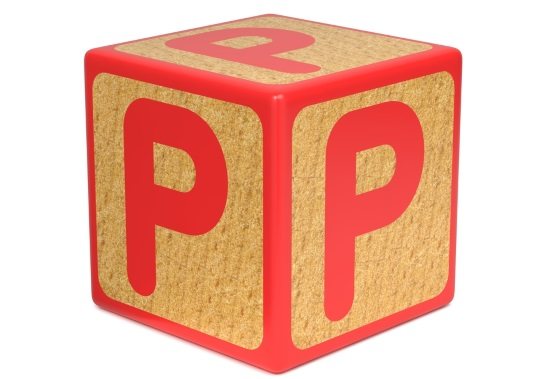
If a child has not learned to pronounce the sound “r” by the age of 5, he will no longer be able to cope with it on his own. You should not expect the child to outgrow the problem. A consultation with a speech pathologist and attendance at speech therapy classes are required.
Another important aspect is long pauses in conversation, or stuttering. This is a complex speech disorder that may take years to resolve. The reason may be:
- increased nervous excitability;
- strict parents;
- too much load on the speech apparatus at an early age;
- imitating a relative or friend who stutters.
Logic and consistency
Coherent speech in a preschooler is the result of many years of efforts by parents involved in its development. Such children speak expressively, use epithets and comparisons, and create their own stories. While the baby, whose speech skills have not been developed by anyone, speaks monotonously and inarticulately.
At 5-6 years old, a child composes a coherent story based on a picture, retells the text he heard, expressing his opinion on what he heard or saw.
Children who spend 90% of their free time on a computer or smartphone have difficulties with the coherence and logic of the narrative. It is difficult for him to answer the question in detail. However, he is ready to talk about his favorite characters in the game for hours. If you do not limit the time you use gadgets, this will negatively affect speech development.
Speech development exercises for practicing at home
It is best to develop a child’s speech at 5 years old through reading. It is useful to memorize poems, proverbs and sayings, solve riddles and read nursery rhymes. It is important that the child finds what is read to him interesting and understandable. The meaning of new words, sayings and popular expressions needs to be explained.
Children always copy the pronunciation and intonation of adults. In order for a child to speak correctly, parents must monitor the quality of their own speech - correctly place stress, inflect nouns, etc. The child’s vocabulary also depends on that of the parents. It is useful to observe natural phenomena together and discuss what is happening, read books and come up with entertaining stories together.
Didactic games
You can increase your preschooler’s vocabulary by playing entertaining games:
- Select antonyms and synonyms. An adult names a word, and the child first comes up with a word that is similar in meaning, and then the opposite.
- What kinds of objects are there? You can invite your child to think about what kind of cup there is (white, red, big, small, round, tall, wide, etc.). The same task can be created for adjectives - what is sweet (sweets, tea, pear).
- The adult names the characteristics of the object, and the child guesses from the description what it is about (round, red, sweet, edible, juicy - an apple).
- Training in declensions in numbers and cases (one apple - many apples, a cat sitting - cats sitting).
Thematic sets of pictures are used for development. You can show your child several cards, from which you need to choose one extra one (sparrow, magpie, swallow, dog). It is necessary for the child to explain his choice.
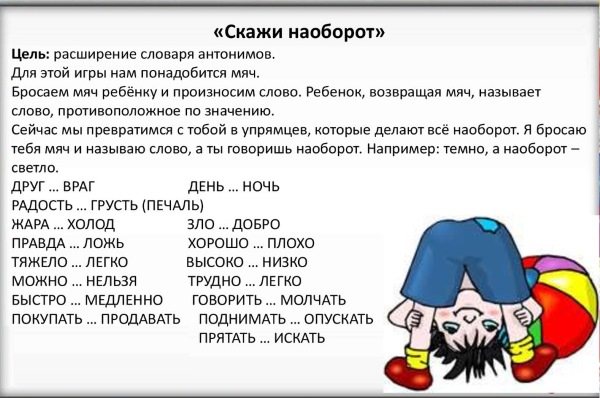
Didactic game for children 5-6 years old.
Didactic games can be carried out in a group of children. To do this you will need a ball or any soft toy. An adult names a generalizing concept (birds). Children take turns naming the birds they know and passing the ball around in a circle. The one who could not name the bird leaves the circle.
A child can be taught to compose coherent sentences from words arranged in random order. An adult calls them randomly (sparrow, branch, sits, on), children compose a ready-made phrase (sparrow sits on a branch).
Development of phonemic hearing
Phonemic hearing is the ability to recognize sounds (phonemes), i.e.:
- identify this or that sound by ear;
- distinguish different concepts that have the same phonemes (cat - current);
- distinguish similar names in which one sound is different (spoon - cat);
- establish the order of sounds in words.
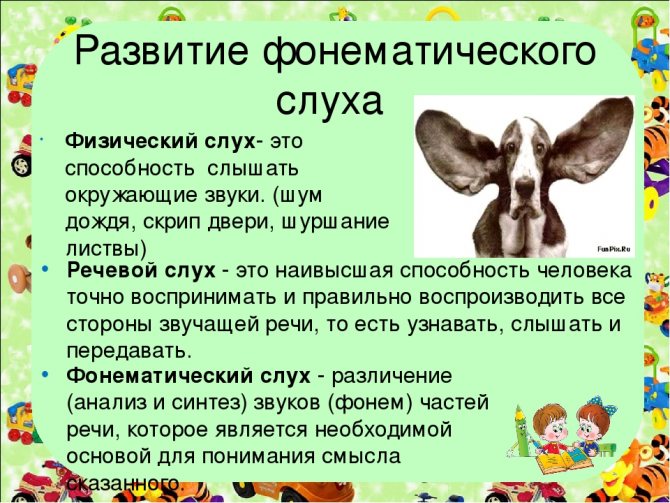
Development of phonetic hearing.
To develop this skill in preschool children, games and exercises are used:
- What did it sound like? An adult puts several sounding toys on the table. It could be a pipe, bell, rattle, drum, etc. The child is allowed to touch and listen to what sounds each object makes. Then he turns away and determines by ear what it sounds.
- Find out by voice. The child turns his back and guesses which family member called him. First, the caller says the name. Then the game becomes more complicated - instead of the name, a short sound signal is pronounced - hey, hey.
- Definition of onomatopoeia - the child must understand what animal the speaker is imitating (imitation of a dog barking, a cat meowing, a cow mooing, etc.)
During the process, the speaker can change the timbre of his voice, volume and intonation.
Finger gymnastics
Exercises for the fingers are carried out in the form of a game and are accompanied by funny rhymes or songs. A light massage is performed first. First, stroke and rub each child’s finger from tip to base, then massage the entire hand. First, the adult does this himself, then you can teach the child to self-massage his hands.
The following exercises are performed:
- Flexion and extension of fingers. First, the adult shows how to perform the movement. Then watches the preschooler perform it independently.
- Static charging - use your fingers and hands to depict any animals or objects: a dog, a bird, a hare, a pistol, etc. You can show your child the tasks on your own hands or let them look at a card with a picture.
- An adult reads a short poem, while the child’s hands “stage” its content. This type of gymnastics combines static and dynamic exercises - objects or characters are depicted with the help of brushes and their action is conveyed.
To improve coordination and fine motor skills, you can perform simple exercises:
- rolling objects of different sizes between fingers;
- picking up pencils or sticks from the table with one hand;
- modeling;
- lacing;
- drawing and coloring pictures;
- weaving from wire or thread.
- stringing beads on wire or cord.
Thanks to such activities, the muscles of the hands develop. This stimulates the speech apparatus and intellectual development of the preschooler.
Articulation gymnastics
There are sets of exercises for the development of the speech apparatus of children.
You can improve the pronunciation of hissing and whistling sounds with the help of speech therapy gymnastics:
- “Fence” - the child bares his teeth and holds his lips in a smile for up to 10 seconds.
- “Stroke” - on a count from 1 to 10, stretch out your lips with a tube and hold it in this state.
- “Fence-tube” - the position of the lips alternates for 10 seconds.
- “Window” - the lips are held in a smile, while the mouth calmly opens and closes.
- Relaxation of the tongue muscles - the child is asked to smile and open his mouth slightly. The tongue needs to be relaxed, made wide and placed on the lower lip. Lightly slapping your outstretched tongue with your lips, pronounce the sounds “five-five-five” for 5 seconds.
- “Spatula” - relax your tongue and hold it in a calm state for 5-10 seconds.
- “Football player” - stretch out your lips with a tube and blow on a ball of paper or cotton wool, driving it into a “gate” of 2 cubes. There is no need to puff out your cheeks. The distance to the gate gradually increases.
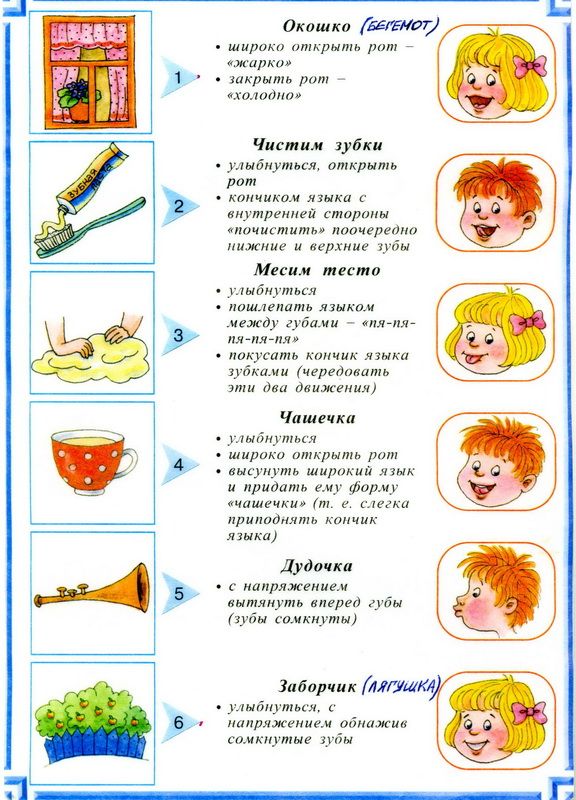
Articulation gymnastics.
If a child speaks the sound P poorly, additional exercises are performed:
- “Painter” - the tongue rises, stretching the hyoid ligament. Open your mouth slightly in a smile, stroke the hard palate with the tip of your tongue from front to back. The tongue does not peek out from behind the teeth.
- “Brushing your teeth” - run the tip of your tongue along the inside of your upper teeth. Keep your mouth slightly open.
- “Mushroom” - open your mouth wide, make your tongue wide and stick its back to the roof of your mouth.
In addition to training individual sounds, exercises are performed to improve breathing.
Generally accepted standards
Normally, a preschooler:
- Knows and follows the rules of grammar. He may put the emphasis incorrectly on an unfamiliar word or make a mistake when changing it. However, if a parent or teacher corrects him, the children remember and do not make any more mistakes.
- Gives a detailed answer to the question.
- Pronounces sounds articulately and clearly.
- He can compose a logical story based on a picture or a series of photographs, come up with his own beginning or ending to a fairy tale, retell a text he heard, share emotions from watching a cartoon or spending time together, playing a game.
- Describes an object and guesses it from the description.
- Can change intonation, voice volume, speed of speech.
- Participates in theatrical performances (at home or in kindergarten), artistically recites poetry, and makes intonation pauses.
- Selects words that are close or opposite in meaning: joyful and cheerful, laughing and crying.
- Actively uses prefixed verbs: the white door is open and the green door is closed.
- Able to generalize concepts: fork, plate, pan - utensils; cat, mouse, dog, rabbit - pets; eagle, thrush, tit - birds.
- Pronounces most phonemes correctly. The exception is the sound “r”.
Diagnosis of speech development of a five-year-old child
There are methods that will help you independently analyze your child’s speech at home and determine whether he has any defects. Let's look at these tasks in more detail.
- Check if the child can describe an object, mentioning its qualities: shape, color, size, material, etc.
- Is he able to control the pace and volume of speech?
- Consider how the child answers your questions: in detail, emotionally, or quite the opposite. Is he interested in conversation?
- Whether he can compose a story from pictures or not.
- Analyze what errors occur in your child’s speech: grammar, pronunciation, stress, etc. This will give you direction for your next steps.
If you notice any shortcomings on one point or another, do not rush to immediately panic and run to the doctor. Of course, speech development at this age is not fully formed. Therefore, mistakes are acceptable everywhere. But, if you understand that the condition is very sad, contact a trusted specialist first. The main thing is to do it on time. Then you can avoid problems in the future.
Signs of speech underdevelopment
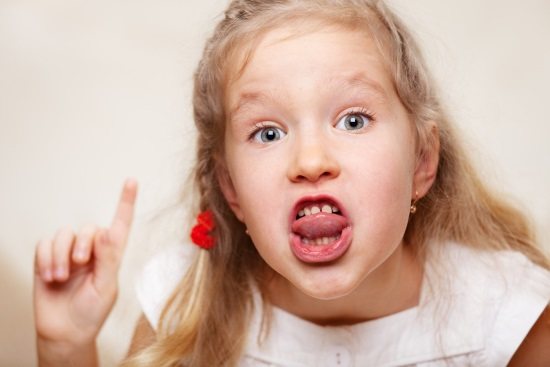
The main sign of speech disorders is a violation of diction and articulation. A child with speech delay pronounces words unclearly, it is difficult to understand him, and as a result, it is extremely difficult to track his speech literacy. Articulation is impaired, most phonemes cause difficulties in pronunciation.
These children have a limited vocabulary. It is noticeable to any adult that he is inferior to his peers in the ability to logically and consistently express his thoughts. Preschoolers with speech impairments are limited to short phrases containing only a noun and a verb. It is difficult for them to describe the subject, formulate and argue their thoughts.
If at least one of the listed signs is present, the help of a speech therapist-defectologist is required.
Diagnosis of speech disorders
To identify speech disorders in children 5-6 years old, ask:
- Describe the action of the person or object in the picture. For example: what is the eagle doing? (flies). What is the girl doing? (combs his hair).
- Indicate the action opposite to that named by the speech therapist: “lay down - stood up”, “ran - stood”, as well as the antonym of the proposed sign: “cheerful - sad, slow - fast”.
- Say what the baby of this or that animal is called. For example: a cat has a kitten, a fox has a little fox, a dog has a puppy, an elephant has a baby elephant.
- Name the shape and color of the drawn figure (triangle, circle, oval, square).
- Describe the item. “What kind of chair?” - “Soft, cozy, warm, with wooden armrests, gray, large.”
- Take a toy that lies ON the table, UNDER the stool, IN the drawer, IN FRONT of the bag, BEHIND the book, BETWEEN the chairs. This allows you to determine whether the baby understands prepositions correctly.
- Convert singular to plural. One nightingale - two nightingales, one drop - three drops, one village - five villages.
- Change the noun by case. What? Bed. Shall I lie on what? Beds. Made what? Bed. Pushed towards what? To the bed. I'll tell you what? About the bed.
- Agree verb and noun according to gender. The cat came into the kitchen. How about a cat? The cat came into the kitchen.
- Name what is shown in the pictures. For this task, pictures are selected in the same color scheme. Red fish, red cherry, red jacket, red flower.
- Repeat difficult words after the speech therapist: excavator, electricity, perestroika, shipwreck, propeller. The baby repeats each word 2-3 times. And the specialist monitors whether the child rearranges syllables, replaces or skips sounds, and whether the stress is placed correctly.
When you need help

Reacting with a smile to words
Experts assure that you can understand what problems may arise in speech almost from birth:
- if by the end of 1 month the baby does not try to let him know by screaming that it is time for him to eat, or when he experiences discomfort;
- if at the end of 4 months he does not respond with a smile;
- if by the end of the fifth month he does not make individual sounds, pointing with his gaze at the object he means. For example, mom asks: “Where is the rattle?”;
- by the end of the 7th month does not try to attract attention with the help of spoken sounds;
- at the end of the 9th month, words consisting of repeated syllables, such as “ma-ma”, “pa-pa”, did not appear in the baby’s vocabulary;
- at 12 months does not respond to simple requests: “Give me a toy.”
Types of speech defects
Before you start classes, you need to know the types of speech disorders:
- stuttering;
- dyslalia;
- nasality;
- neurological diseases.
For your information! To identify them, you just need to regularly communicate with your child.
Formation of graphomotor skills in children with general speech underdevelopment
Basic characteristics of speech at 5-6 years old
By this time, speech develops and becomes more complex. The baby is already able to make hissing and whistling sounds. The expressiveness of speech increases, you can notice this when reading poetry and in role-playing games. It becomes coherent and sentences become more common. Children are already able to retell a fairy tale or describe a picture.
How to deal with violation
The level of speech development of a preschooler depends on the diction of the adults around him, the specifics of upbringing in the family, and the efforts made by parents. By completing simple tasks for speech development, the child learns skills in a playful way that will be useful to him at school.
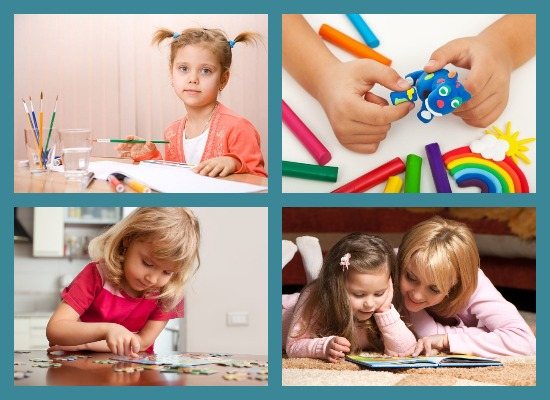
Spending time together with parents is of no small importance: active recreation, visiting museums and theaters, drawing, modeling, folding a puzzle, discussing pictures in a book, while simultaneously commenting on one’s feelings and emotions. All this is a powerful stimulus for the child’s speech development.
Doing exercises to train diction, memorizing counting rhymes, tongue twisters, riddles and poems allows you to correct pronunciation and enrich your vocabulary. It is important to clarify unclear words and phraseological units so that the preschooler can use them correctly in the future.
Speech therapists recommend reading aloud to your child as much as possible. After reading, you should discuss the fairy tale or story, explain the meaning of new words, and evaluate the actions of the characters.
Speech development tasks for children 5-6 years old allow you to develop skills in logical presentation and argumentation of thoughts:
- compiling a story based on a picture;
- detailed answer to questions based on the text;
- retelling what was heard.
You should stop the baby, correcting incorrectly pronounced words and ask him to repeat the word without error. Home theater will allow the child to show his acting abilities, learn to use his voice, making it quieter or louder, use intonation, and pause.
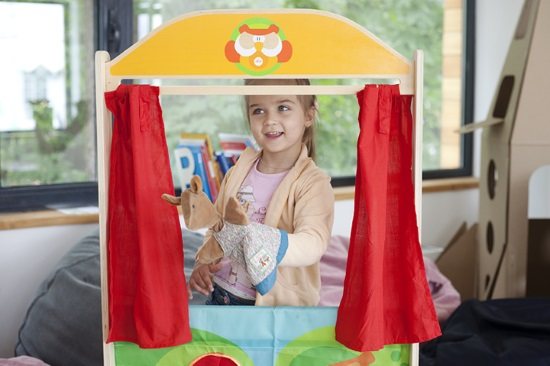
The development of oral speech is the basis for mastering reading and writing, as well as the key to successful learning at school. Therefore, it is worth starting classes as early as possible. And if violations are detected, consult a speech therapist and correct the pronunciation.

Prevention of speech delay
The formation of a senior preschooler’s perfect speech is influenced by his living conditions, the characteristics of his parents’ upbringing style, and, most importantly, the efforts of caring adults. To avoid finding yourself on the threshold of school in a situation where a child has discovered numerous speech disorders and there is no time to correct them, you need to take care in advance of the harmonious development of the child’s speech.
To solve this problem, close communication between children and adults is of great importance. Walking together, doing creative work, looking at book illustrations with a parallel discussion of what they saw and felt. This work will give a powerful impetus to the development of the baby’s speech. It is very valuable to learn and use such rich material as counting rhymes, tongue twisters, poems, riddles, sayings, nursery rhymes, and proverbs. All words that children do not understand need to be explained and ensure that they are used correctly.
Reading children's literature should be accompanied by a conversation about the actions of the characters and an explanation of incomprehensible words. When memorizing poetic works, it is very useful to replenish a child’s vocabulary by drawing his attention to the figures of speech used by the author. “A dark forest that covered itself with a wonderful hat...” “What hat did the poet write about?” “And fell asleep under her quietly, soundly...” “Do you think the forest can fall asleep?” “How do you understand the word restlessly?”
In order to fully prepare for schooling, a child of five to six years old must be able to coherently express his thoughts and construct logical, complete statements. It is important to correct deficiencies in sound pronunciation in a timely manner, to teach children to use their voice and means of expression. If children receive a lot of positive information from the outside world and from fiction that they can discuss with adults, this greatly stimulates children's speech development.



